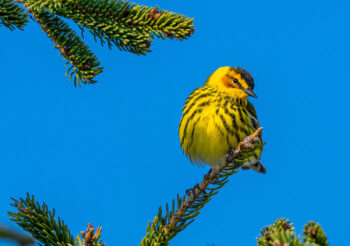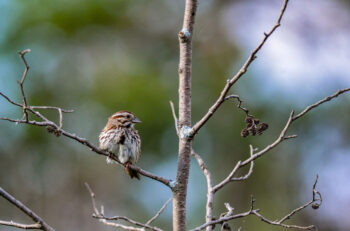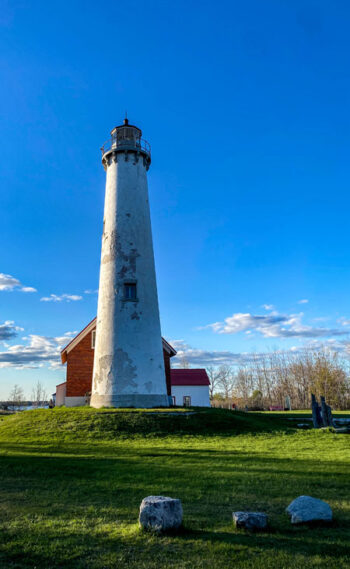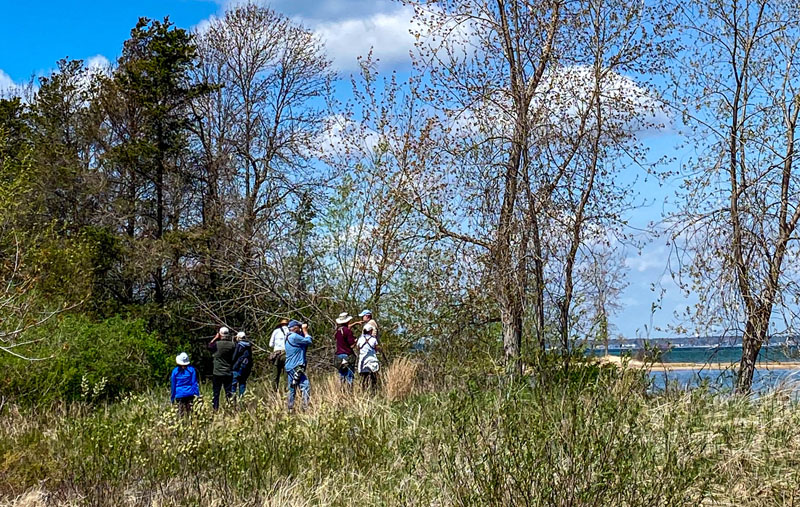By LUCY BAKER, Lighthouse keeper volunteer
EAST TAWAS – The sun was already perched high above Lake Huron when I stepped through the mayfly-covered screen door of the keepers’ quarters, down three creaky steps and into my first day as lighthouse keeper at Tawas Point in Iosco County.
My keeper duties were not set to begin until noon, so I decided to spend my first free hours exploring my new temporary home on foot.
I knew what to expect going into my two-week-long shift as keeper. I am a student in the Great Lakes Writers Corps at the University of Michigan.

I would be giving lighthouse tours to upwards of 50 visitors a day, doing research about the Great Lakes for one of my college classes, and hopefully spending some time recovering from and reflecting on my sophomore year of college, which had ended only a week before this new adventure began.
What I didn’t expect, though, were the birdwatchers.
The biggest tourism season along Great Lakes beaches unofficially begins on Memorial Day.
With it being two weeks prior to that, I was surprised to see hundreds of people already walking past the lighthouse and strolling the beaches that morning.
Birdwatchers, or “birders,” flocked by the thousands to Tawas Point during the whole month of May, many traveling from out of state to attend the annual Tawas Birding Festival. The peak of bird migration typically occurs during the third week of May, my first week as keeper.
Although the water’s edge of the fourth-largest lake in the world, Lake Huron, was over 200 yards to my left, I could still hear the waves clearly. Their rhythmic crashing and the early summer sun reminded me of some of my most pleasant memories of childhood, where I would spend all day in Lake Michigan swimming and surfing almost every warm summer day.
The other, more visible body of water – Tawas Bay – sat quietly and calmly only a few
yards to my right. The point is technically surrounded by the same body of water, but the east and west sides have completely different temperaments.

The path I planned to walk split Tawas Point down the middle, and it conveniently began only a few steps away from the back door of the lighthouse.
The point itself extends south out into Lake Huron for about 2 miles and marks the northern edge of Saginaw Bay. The southernmost half of the point is a state park managed by the Michigan Department of Natural Resources.
The Sandy Hook Nature Trail, which I was set to explore, winds through the state park and is carved by the feet of thousands of visitors from all over the world every year.
“STOP – PLEASE READ.” I tend to not be a sign reader, but this sign that sat at the start of the trail seemed to have an important message. It also had manners. I obliged.
The land that the Sandy Hook Nature Trail sits on is defined by the DNR as Primitive Zone – an underdeveloped recreational experience. “Pets, bicycles and unauthorized vehicles are NOT permitted beyond this point.”
I began to walk.
Young cottonwood and birch lay ahead of me, lining the trail. Through the thinnest parts of the wooded areas there were small visible patches of wetlands and beautiful beaches.
It turns out I was a few days late for the actual birding festival, but right on time for peak bird migration.
Historically, birdsong has only served as background noise to me anytime I’ve gone outside or heard it faintly through my bedroom window as the sun rises. This is just something you get used to as a Michigander.
But, as I passed the entry signs to the trail and continued my walk, birdsong became all I could hear. I became aware of the sound of my own footsteps on the soft, dirt trail. Heads turned as I accidentally stepped on small sticks, creating obviously unwanted noise.

My dad, an avid outdoorsman, has always watched birds. His binoculars and red leather-bound bird identification book have sat on the same shelf in our living room for as long as I can remember.
He has always kept the bird feeders on our back deck stocked full of bird seed and simple syrup (for the hummingbirds – his favorite). His email address and social media handles are all different iterations of the phrase “finch master.”
All this, yet I’ve never really considered him a birdwatcher. These people on the point, though, were birdwatchers.
Many of them would say that birdwatching is not a mere hobby, but a lifestyle. Many of their vacations to Tawas were planned with the intent to catch a glimpse of a Cape May warbler or a white-crowned sparrow.
In athletic shorts and a University of Michigan T-shirt (an outfit that would usually allow me to blend in), I felt like I stood out. The people around me wore camouflage, countless shades of tan and binoculars around their necks.
Some of them walked slowly, but most of them stood still, their necks craned and their eyes peering through spotting scopes or cameras.

With my naked, non-birdwatcher eyes, it was hard to spot any birds nestled in the dense trees. Barely audible whispers, points toward rustles in leaves or a set of wings above, and a few helpful tips from some kind birders on the trail helped me identify a few birds, though.
I learned to identify a magnolia warbler by its yellow belly, a piping plover by the distinct black mark on its forehead, and a double-crested cormorant by its size and matte black appearance.
“Monarchs of the Marsh.” Again, I’m not a sign reader, but at the leisurely pace I was traveling, this sign about halfway down the trail seemed like a good place to pause the interruptions my footsteps were causing the birders.
The point, it turns out, provides a perfect home for monarch butterflies. The fragrant flowers of the common milkweed, which find a home on the marshy point, are the only sources of food for monarchs.
This rugged, sun-bleached sign was the first thing that helped me understand that this mere 200-acre chunk of land is more ecologically important than I ever could have imagined.
It also serves as a refuge for white-tailed deer, red foxes, snakes and countless more creatures that call Michigan home.
By the time I reached the end of the point, which looked out into the vibrant blue waters of Saginaw Bay, I understood why Tawas Point is nicknamed the Cape Cod of the Midwest.
I also passed at least 300 people who were there just to watch birds. Some of them traveled in groups, some alone, but they rarely talked. They just admired the birds, and I admired them for their commitment.
With each step, I questioned their lifestyle less and less.

Being out on the point was immersive – a brief, indescribable escape from the worries of life. I felt as much a part of nature out there as I’m sure a cottonwood does.
I realized, as I sat on a weathered bench halfway buried in sand, that maybe birdwatching is actually not just about looking at birds. It’s more about feeling connected, whether it be to the birds, to nature or to one another.
“In 2007, Tawas Point was designated by BirdLife International and the National Audubon Society as an Important Bird Area,” a sign at the end of the trail read.
This small yet mighty piece of land is part of a global network of key sites used to protect bird biodiversity. It’s just a small link in an immense chain of interconnectedness, acting as an important corridor for migrating songbirds, shorebirds and waterfowl each spring.
Around noon, after I had walked the trail back to the lighthouse and done some light cleaning of the lighthouse museum, it was time for the first visitors to arrive and time for me to host my first tour.
My keeper nametag, Tawas Point Lighthouse T-shirt, and walkie-talkie strapped to my waistband let everyone know I was an expert.
All I knew so far, though, was that the lighthouse was built in 1876. The rest of my facts I would read out of a binder provided by the DNR. However, over the next few days, I was quickly able to answer even the most obscure questions about the lighthouse and point.
I was told in training to expect around 15-20 people per group, that each tour would start on the hour and that the last tour would begin at 4 p.m.
That Wednesday, only eight people came to tour the lighthouse.
They were all birders.
Learn more about Tawas Point State Park and Lighthouse at Michigan.gov/TawasPoint.


